Personal finance is an exciting hobby and topic.
BUT, it’s also an incredibly lucrative niche.
Personal-finance blogs are growing increasingly popular among bloggers. The industry is currently estimated to be worth an impressive $1.35 trillion.
And according to Google trends, the personal finance niche is EXTREMELY STABLE and has been for the past five years.
In other words, it’s an evergreen niche – and one of the most profitable niches to start a blog.
So, if you’re ready to learn how to start a personal finance blog, let’s get to it!
Editors Note
This guide is extremely DETAILED and explains everything you need to start a Personal Finance blog. I’ve been at this blogging stuff for over 8 years and have built a business making $20,000 per month, so I have a lot of helpful advice for you newbies out there.
If you get stuck or need advice, I HIGHLY recommend that you get my 100% FREE blogging course by clicking here. If that doesn’t help, please contact me directly, and I’ll help you out for free.
How to Start a Personal Finance Blog in 10 Steps:
If you just need someone to walk you through setting up your blog quickly and easily, check out step 5.
Before we dive into the ten steps of how to start a personal finance blog, let’s look at the different reasons why someone might want to enter this space.
- Share Your Expertise
- Build Your Resume
- Improve Your Writing Skills
- Make Money
- Do Something You Enjoy
- Help Others Become Financially Educated
- Start a Business Creating Info Products
- Share Interesting Findings
- Get Noticed in the Personal Finance Sphere.
Those are just a few of the MANY reasons you might have for starting your blog in this industry.
With that out of the way, let’s move on to the first step you need to take to start a blog in finance right now.
1. Decide the Focus of Your Personal Finance Blog
Finance blogs come in all types.
This includes blogs to help people budget, reduce debt, save money, and achieve financial independence.
Starting a personal finance blog can be highly lucrative whether or not you have an accredited financial background.
The first thing to do is decide the focus or direction of your new personal finance blog.
As I mentioned earlier, finance is a vast industry, and there are many different ways to position yourself to start a blog that will be profitable in the long run.
Below I’ve listed ways to help you fire up your brainstorming process.
- Trying and reviewing personal finance products.
- Start a blog that will compliment a YouTube channel
- Growing a personal finance community
- Creating a fully transparent finance blog sharing personal income reports
- Sharing “Saving Money Lifestyles,” such as frugal living, homesteading, retiring young, etc. You can even setup a lifestyle blog if you’d like and make this a category you blog about from time to time.
These are just a few ways to start a personal finance blog.
It’s essential to take the time to define your blog’s focus, as this will help guide your efforts during the rest of the steps – particularly when it comes to search engines, creating content, and monetizing your blog.
Regardless of the direction you take to start a blog; you will never be short of an audience.
People are continuously moving up and down the economic ladder.
Once you’ve chosen your blog’s focus, it’s time to choose a niche.
2. Choose Your Personal Finance Niche
Choosing a niche for your blog is a CRUCIAL part of the process.
If your topic is too broad, such as focusing on “personal finance” in general, you’ll find it hard to target an audience of people interested in your content.
For instance, if one of your readers is only interested in personal finance advice for millennials, they won’t read your blog regularly because you’ll be blogging about other topics like “how married couples budget their money” or “different side hustles for couples to make extra money.
The great thing about the personal finance niche is that it’s a HUGE and EVERGREEN NICHE.
You won’t have any trouble finding topics to focus on for your new blog.
The trick is to niche down to a topic that doesn’t have too much competition from other bloggers. With a regular publishing schedule, you can build an engaged audience and build your google analytics and search engines optimizations.
Here are some ideas for the different niches:
- Saving: A lot of people are eager to learn how to save money and attain financial freedom so you might start a blog on money-saving ideas
- Debt: Share information about debt consolidation, management, or repayment. You can also talk about bankruptcy.
- Budgeting: Teach people how to budget their income and share money-saving hacks with your audience.
- Credit: You might consider writing articles on credit company reviews, credit repair, building credit, etc.
- Loans: You can discuss payday and student loans or review loan companies on your blog.
- Investment: Your blog might focus on investment tutorials, technology, real estate investing, or investment firms.
- Side Hustles: Help others create financial independence with a blog that focuses on side hustles such as how to be an affiliate marketer, sell digital products, create an online course, sell an online course, make product sales or start your own business and start a blog.
- Minimalism: Frugal living and minimalism are among the most successful micro-niches in personal finance.
- Insurance: Life, health, business, disability, liability, home, pets, car, credit card, etc. – take your pick!
- Financial Planning: Topics can include financial planning for families, annuities, wealth management tools, ways to retire early, being a mom managing money, etc.
- Taxes: Share information on personal income tax, corporate taxes, tax deductions, tax planning, tax credits, etc.
As you can see, there are TONS of ideas for a personal finance blog niche.
Regardless of which one you choose, you’ll have plenty of opportunities to provide value to your audience.
After all, most people aren’t taught how to manage their finances (at school or home).
This often leads to them searching online to educate themselves about this important life skill.
So, now that you have your niche let’s move on to the next step, where you can choose your blogging platform and teach people to achieve financial freedom.
3. Choose Your Blogging Platform
Before opt for starting a finance blog, you need a platform to build your blog.
Many blogging platforms are available to choose from; some are free, and others are paid.
Free blogging platforms like Blogger, Wix, and Squarespace may seem enticing to someone just getting started.
BUT…
It’s important to note that these basic hosting plan platforms have drawbacks limiting your ability to monetize your website.
Here are a few disadvantages of using hosted (free) blogging platforms:
- Unprofessional Look: Most free blogging platforms have a generic look, making it hard to build a high-quality, professional-looking, and successful blog using a free tool.
- Lack of Control: The hosting provider can add their ads to your own website. Sometimes, the ads aren’t even related to your own content, making them appear even more unprofessional.
- Few Customization Options: You’ll find it very hard to customize a free blog if you don’t have the necessary technical skills.
- Limited Monetization Potential: It’s extremely difficult to monetize a free blog as you won’t be able to use many monetization methods, i.e., search engine optimization for Google or other search engines
- You Don’t Own the Site: Neither the website nor its content belongs to you, as the hosting provider can delete your website if you violate the terms of use.
Now that you know the drawbacks of using free blog hosting, you’re probably wondering
“What should I use instead?”
Self-hosted WordPress.
It’s the best choice for building your blog on a solid foundation.
Here’s why it happens to be the best content management system:
- WordPress powers 39.6% of websites on the internet, so you are assured of excellent site speed.
- 64.1% of CMS-built websites are WordPress
- WordPress websites receive over 400 million people every month
- 661 WordPress websites are created each day
- There are over 50,000 free plugins for WordPress
- You can choose from over 3,500 GPL-licensed themes
If these recent stats haven’t convinced you, here are a few other reasons why you should choose premium WordPress:
- WordPress is free to use forever
- You can extend your website’s functionality with a few essential plugins
- It’s easy to customize your website without any coding
- You can monetize your blog in a wide variety of ways with a membership site too
- WordPress has a ROBUST customer support system
So, when it comes to self-hosted vs. free alternatives, I hope it’s clear to you that WordPress is undoubtedly the best choice.
Now that you’ve chosen your blogging platform, let’s move on to the next step.
4. Decide on Your Domain Name
Your domain name refers to what you will call your blog when you start a personal finance blog.
Most people spend excessive time picking the PERFECT name, and they never get around to building a blog.
Make sure you avoid this common pitfall by following the steps below to help you choose an excellent name for your own blog.
This should be a reasonably fast decision, and you shouldn’t spend more than a couple of hours on the task.
1. Choose “.com“: There are tons of different free domain extensions you can choose from, especially for finance blogs, but it’s always best to stick with “.com” as this is the easiest for your audience to remember.
2. Leave Yourself Room for Expansion: Don’t choose a domain name that is too specific. This will limit the content, products, and services you can offer on your blog. For example, a blog name like “Afford Anything” is better than “Afford College” since you can focus on a broader range of personal finance topics.
3. Keep It Short and Sweet: Choose a short and easy name to remember. For example, a name like “Everything Finance” is better than “Everything You Need To Know About Finance.”
4. Use Alliteration: Alliteration refers to words with the same first letter or sound, such as “Dollar Divas” or “Managing Midlife.”
5. Use Creativity: If the name you want has already been taken, get creative by using synonyms, slang, or even the same words in different languages. For instance, “Mad Money” might become “Mad Moola” (or something like that…)
6. Add Other Words: You can also add words like “the,” “blog,” “club, “etc., to help you get the domain name you want. For instance, “Budget Buddies” would become “The Budget Buddies.”
7. Think of a Branding Concept: Another way to help you brainstorm the perfect name for your new personal finance blog is to think of a concept around how to brand your blog. Where do you want it to go in the future? Answering this question will help you think of a name aligned with your blog’s true purpose.
8. Use a Name Generator: If you are stuck, use the free domain name generation tools like LeanDomainSearch.com and InstantDomain.com. Enter a few keywords, and the device will present you with an endless list of possible names for your new blog.
9. Don’t Purchase a High-Priced Domain Name: Avoid purchasing a high-priced name. Instead, start with a standard domain and use the money to create content for your new personal finance blog. You can always buy the name you want later from your blog’s profits.
10. Do Not Get Stuck Here: As I mentioned before, many people tend to get stuck at this stage. Prevent that from happening to you by following the steps above. First, choose a name you like, and move on to the next step.
Examples of Popular Personal Finance Blogs (and why their names make sense)
1. Wallet Hacks
This blog name makes sense because it’s short, unique, and easy to remember.

2. Debt Discipline
This blog uses alliteration to create a memorable name.
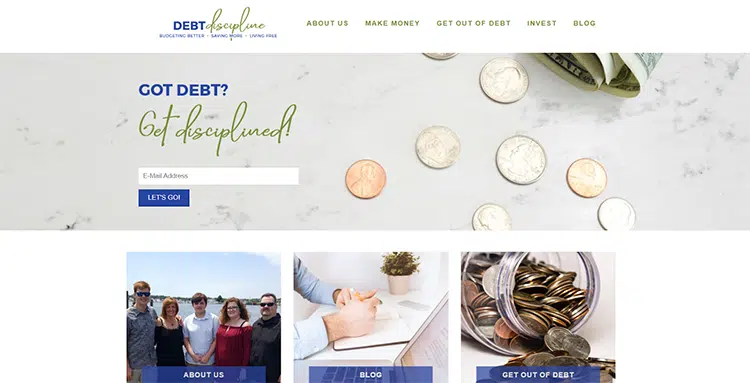
3. The College Investor
This blog name works well because it’s short and to the point. In addition, it makes it very clear precisely what the blog is about.
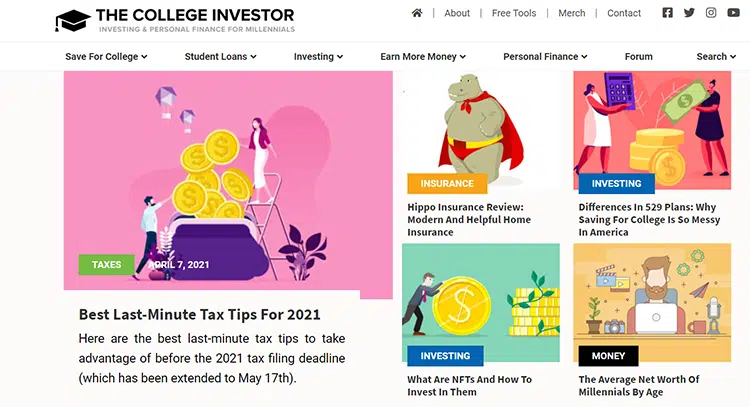
5. Buy Your Domain Name and Web Hosting
Once you’ve chosen a name for your domain, you can proceed to purchase the name and your website hosting service.
A domain name is the name of your new blog.
So, if your blog’s name is “My Awesome Finance Blog,” your domain name will be “MyAwesomeFinanceBlog.com. “
Hosting is a service provided by companies to ensure that your blog is always available online.
It’s like renting business space, but on the internet.
Web hosting companies keep your files on their servers to ensure your audience can always find your content at all times.
There are tons of hosting services to choose from, but I recommend BlueHost for all your web hosting needs.
This is a reliable company that has been around for a LONG TIME.
They offer affordable prices, particularly for bloggers who are just getting started.
Below, I will take you through the step-by-step purchasing of your domain and hosting account.
Click this link to visit BlueHost and follow along with the tutorial below.
Step 1: If you haven’t yet, click on this link, and you’ll be brought to the WordPress Hosting page you see below.
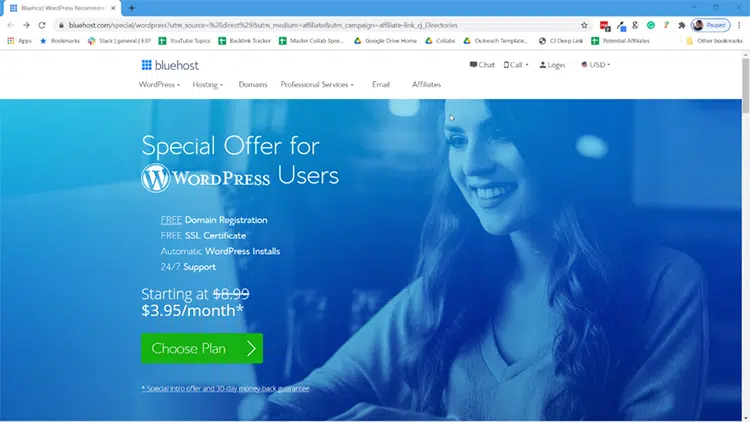
Step 2: You’ll be brought to the hosting plan page next. You could choose to get a “Plus” or “Choice Plus” plan, but that’s not a requirement.
The Startup plan is the cheapest at $2.95/month through my link vs. the average of $8.99/month.
This plan has everything you need including 50GB of web space (plenty of room for your files), a free domain name for a year, plus other standard features like a free SSL and a secure WordPress install for site security. Feel free to browse to decide on the right plan for you and your domain names, but rest assured that Basic will work just fine if you want to minimize your investment.
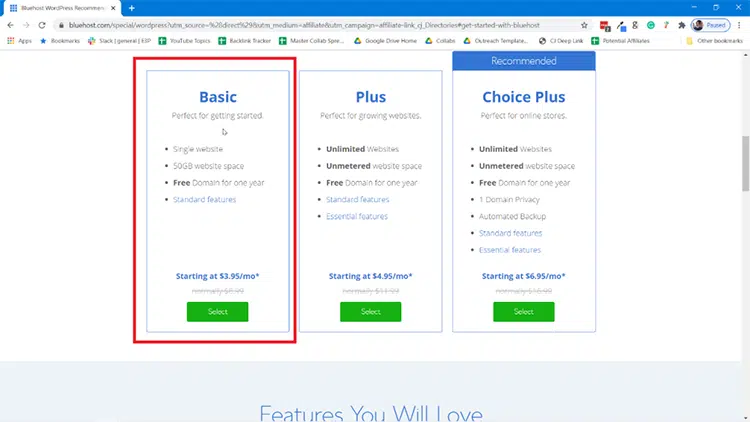
Step 3: After clicking on the plan, you’ll be brought to the next page where you will type in your new domain, or you can just choose “I’ll create my domain later” if you haven’t decided yet. The domain is the URL people will type into a browser to view your website in the future.
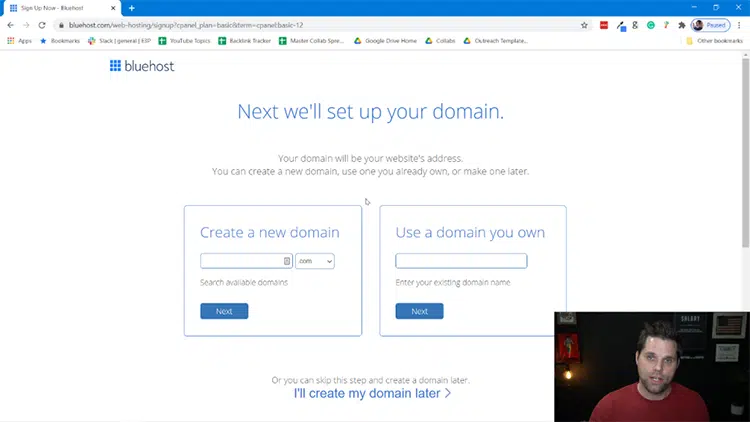
Step 4: The next page will ask for your information once you submit it. That will start with your account information, which is self-explanatory.
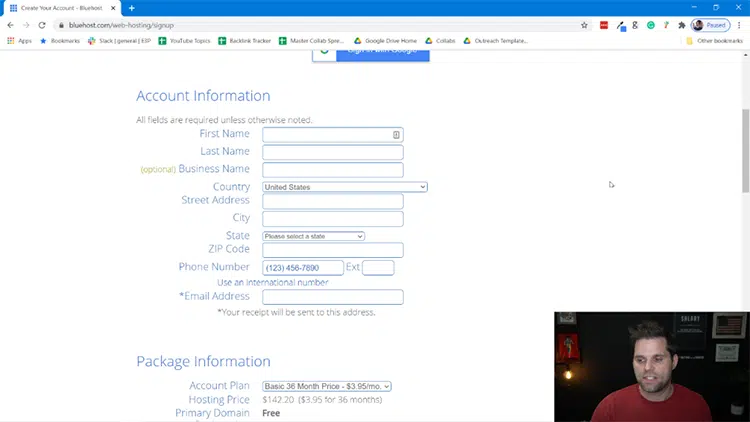
Step 5: Next, you’ll have to input your Package Information. This is to choose how long you want the hosting plan to go with this hosting platform. I advise you to choose 24 months to get the discount and save some money, but you can go as low as 12 months if you want for your domain names.

Step 6: You’ll have to choose what “Package Extras” you want. You can scroll over “More Information” to understand each item, but here is my advice.
I would get the “Domain Privacy + Protection.” This makes it so that no one can tie your name to the domain name you create. The only other one worth considering is “Codeguard Basic.” The other two I wouldn’t personally get. But choose what is best for you.
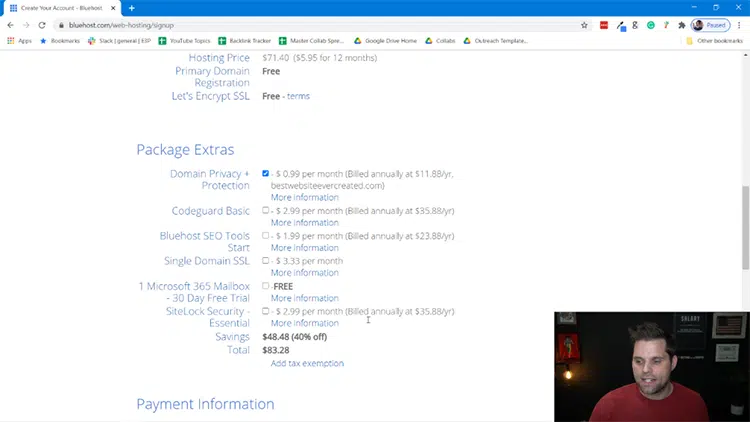
Step 7: The next step is Payment Information, which is self-explanatory.
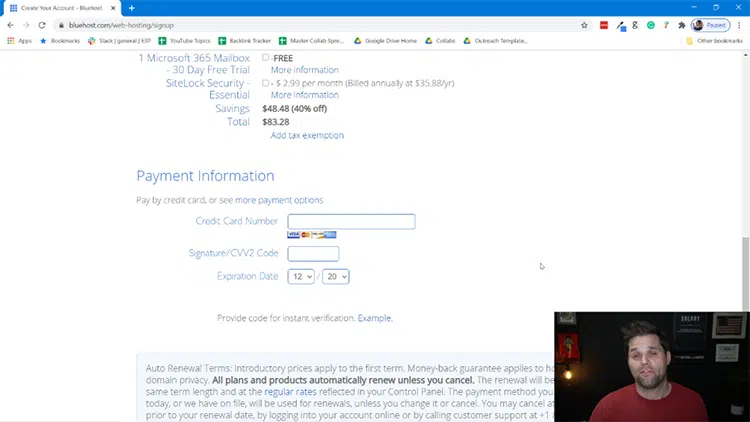
Step 8: The final step of signup is to confirm that you read and understand the Bluehost Terms of Service, Cancellation Policy, License and service agreements, and Privacy Notice. Click the check button and then click “Submit.”
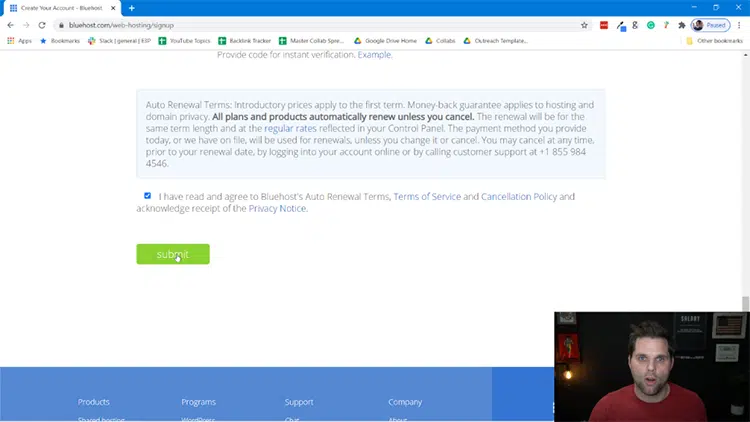
Step 9: Next, you’ll be prompted to create an account and password. You’ll use this information to log in to the Bluehost platform to manage your site and account info.
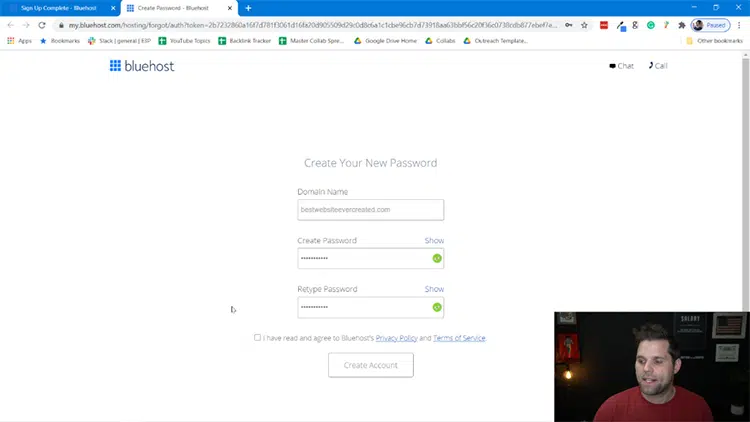
Step 10: At this point, Bluehost puts you through a short questionnaire to better understand your scenario. You can answer all of these questions or click “Skip this Step” at the bottom. If you’re a newbie, I advise you to answer the questions as it’ll help your onboarding experience.
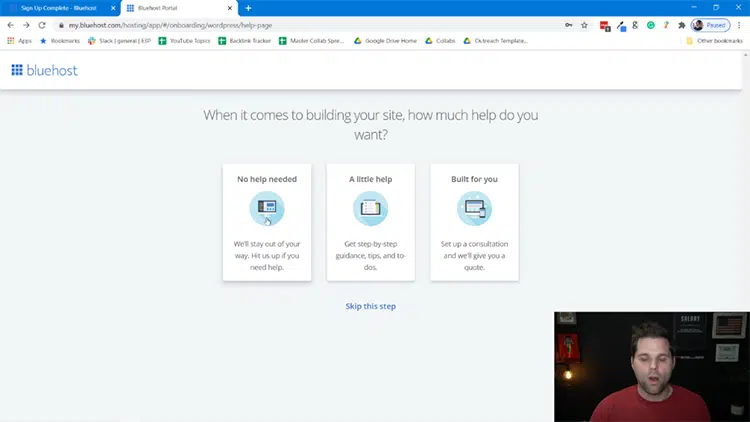
Step 11: After doing that, you’ll be advised to choose a theme. For now, you can just decide to use a free theme. But, of course, you can always replace the theme later if you’d like.
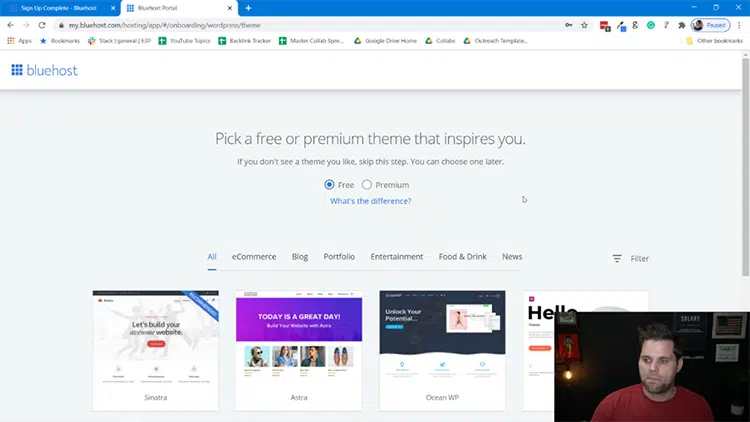
Step 12: You’ll be brought into the backend of WordPress in the admin panel. This is where you’ll manage your site from. You can add posts/pages as you see fit, but click on the blue button that says “Launch Your Site” when ready.
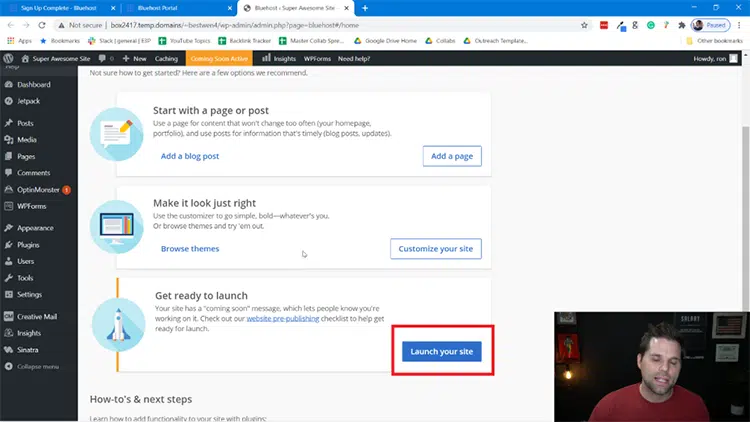
Step 13 (Final): Your blog is LIVE. Just go to a browser and type in your own domain name. Once you do this, you’ll be able to access your website!
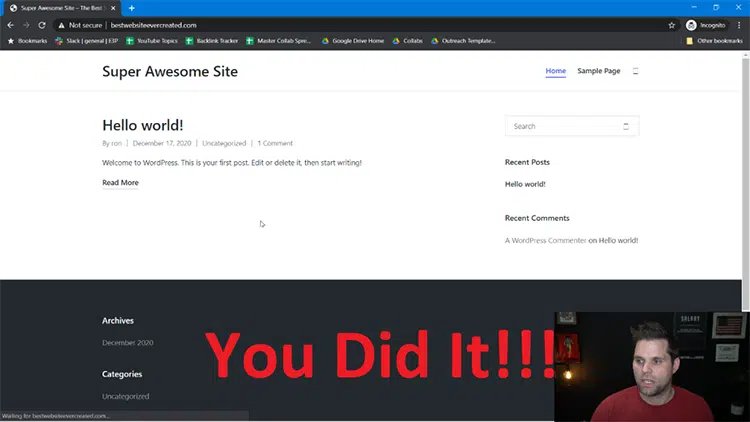
Congrats! You officially have a website with your own domain name.
If you’re wondering how to edit things on the website, all you have to do from here is go to your website URL with /wp-admin at the end in a browser and log in.
Example: http://mostawesomewebsiteever.com/wp-admin
And don’t worry, we cover how to edit things more in the rest of this guide. So please continue reading.
6. Choose and Install WordPress Theme For Your Personal Finance Blog
A theme is simply software that dictates how your WordPress website looks.
There are different themes for different types of blogs.
When you first install WordPress, it comes with a default theme. But, if you want to build a professional-looking website, that’s not the theme you want to use.
You need to choose a specifically designed theme for personal finance blogs.
It should be one you can customize so your blog post can be truly unique and stand out from the rest.
WordPress has thousands of free and paid themes to choose from.
Again, I advise that you steer clear of free themes if you are serious about building a high-quality website that you will monetize over time.
Choose a premium WordPress theme so you can enjoy the many benefits that come with it, such as:
- User-friendly design perfect for beginners
- Full customization abilities and web hosting
- Clean code for a fast, high-ranking site
- Fantastic range of templates for videos and images
- Free WordPress theme updates for life
- Full technical support for your site and web hosting options
You won’t get any of these benefits with a free theme.
And even worse, some free themes come bundled up with malware that could potentially damage your website.
Below are a few theme options to help you in your quest to find an excellent theme for your new personal finance blog.
Personal Finance Blog Theme Options for WordPress
- Divi: If you’re looking to design a stunning website with ease, Divi from Elegant Themes stands out as arguably the best WordPress builder available today. Its intuitive visual drag-and-drop interface empowers users to craft amazing sites quickly. What sets Divi apart is its vast array of customizable modules, real-time design feedback, and a responsive editing feature that ensures your website looks impeccable on any device.
- Astra: While Divi is renowned for its versatile design capabilities, the Astra theme offers a distinct set of advantages for those prioritizing speed, performance, and seamless integration. Astra stands out for its feather-light weight, ensuring that websites load at lightning-fast speeds—a critical factor for SEO and user experience. Moreover, Astra’s deep compatibility with major page builders, including Elementor and Beaver Builder, means that users aren’t restricted to a single design environment. The theme is also built with a focus on customization as well. You can read my Astra Theme Review is you want to learn more.
- Themeforest.net: Themeforest has a significant amount of themes far beyond other platforms out there. There are over 48,000 total themes available on this platform, so you can find whatever you need.
Here are some specific themes to consider as well:
Bayar – Simple Personal Banking Admin Dashboard Figma Template
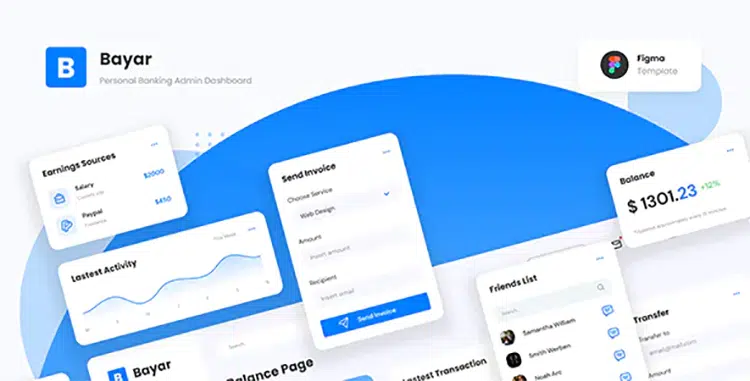
This simple yet powerful theme will help you organize finance reports and transactions and create high-quality blog posts for personal finances. It has a personal banking admin dashboard suitable for digital money, digital payment, payment admin, invoices, etc.
Finance and Business

This theme is clean and modern. It has everything you need to build a successful personal finance website, such as consulting firms, investment firms, financial advisors, and any other type of corporate website.
Payday Loans – Banking, Loan Business, and Finance WordPress Theme
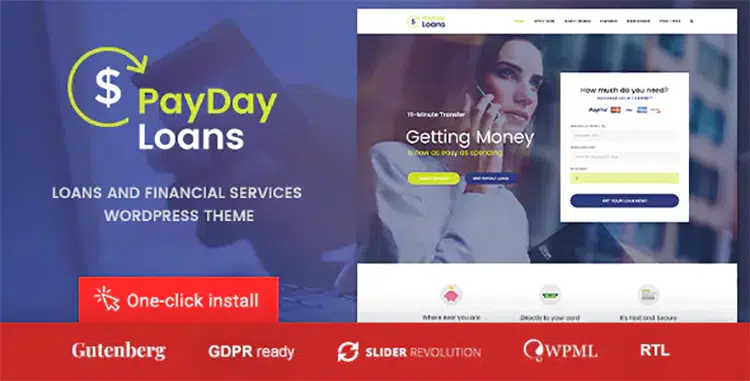
This theme is excellent for any business in the finance sphere, such as banking, consulting, financial freedom, business, personal loans, credit cards, insurance, and Forex trading. The theme has dedicated finance functionality, including calculated forms.
7. Create Essential Pages & Logo
Now, everything is in place for you to start creating the essential pages of your blog.
These include the “About” page, “Contact” page, and “Privacy Policy” page.
Let’s take a closer look at each:
About Page
Readers that come to your blog will be curious about who is behind the articles they are reading.
Many will click on your About page to discover more about you.
This page is one of your blog’s most important (and most visited) pages.
Take the time to craft a well-thought-out page with some history about yourself. Include your name, how old you are, and where you live.
You can also include information about why you started the personal finance blog and what you hope to achieve with it.
It’s also a great idea to add an image of yourself on this page.
Contact Page
Next, create a Contact page with all the details readers need to get in touch with you.
You can also include a contact form on the page so visitors can have a convenient way of sending you messages.
Make sure you include your social media platforms and profiles on this page with a call to action for visitors to connect with you on the platforms where you publish and promote your content.
Privacy Policy Page
If your finance blog attracts readers from jurisdictions with privacy laws, it’s crucial to have a Privacy Policy page as the blog owner.
There are privacy policy generators online where you can create one for free and earn money online.
Alternatively, you can get a legal professional to draft this and other legal pages, such as Disclosures and Disclaimers, Terms and Conditions, cookie policy, etc.
Create a Logo
Once your legal pages are done, it’s time to create a logo for your personal finance blog. I’d recommend that you do that by using one of these online logo makers as they’ll get the job done quickly and affordably.
However, if you need high-resolution logo files, there’s a minimal fee to access the files and a few other things.
8. Begin Blogging

This part is why you’ll truly appreciate the time you spent finding the focus and direction of your blog and choosing a niche.
This will make it much easier to develop topics for your new WordPress site.
For example, say you chose the focus/direction of your WordPress blog to be:
“Growing a personal finance community.”
And your niche is:
“Frugal Living”
Can you see how this makes it easier to develop topics to start a blog that resonates with your target audience?
You can then break down each topic into various categories and write personal stories under each category.
Here are some more examples from various finance niches:
Niche: Saving Money Lifestyles
- Minimalism
- Frugal living
- Homesteading
- Cash-only living
- Urban thrift
- Retiring young
- Personal journey out of debt
- Blogging Journey / Your journey toward a financial goal
- Financial Independence
Niche: Money Saving Hacks
- Couponing
- Budgeting
- DIY
- Saving money methods
- Reusing or secondhand
- Money management skills
- Credit card reviews
- Debt management
- Travel hacks and savings
Niche: Debt
- Debt consolidation
- Debt repayment
- Bankruptcy
- Debt collection services
- Debt management
- Handling debt collectors
Important Note: You must have at least ten posts published on your blog before you start promoting anything.
You last want to send visitors to a sparsely populated blog.
This will make you look unprofessional and reduce the chances that those visitors will return.
9. Promoting Your Personal Finance Blog
If you followed all the steps above, you’re now ready to start promoting your blog.
Below are some of the most commonly used and effective blog promotion techniques.
Tell Friends and Family
You can share your blog with friends and family as soon as your blog is live. Ask them to check it out, read your post, and share your content with others in their networks. This will provide valuable feedback to improve your blog and give you additional exposure to new audiences.
Use Social Media
I don’t have to tell you how powerful social media is for promoting content. Share the link to your blog on your social media profiles and ask your friends and connections to visit your blog and start making money online. You can take this a step further by seeking out relevant groups in the financial community and sharing your link there.
Join Blogging Communities
On LinkedIn, Facebook, Reddit, and other platforms, you will find a lot of groups whose purpose is to help bloggers promote their new blogs. Join these groups, share and comment on other people’s posts, and then share links to your blog content so others can read your content.
Write Guest Posts
This is one of the most effective ways personal finance bloggers direct traffic volume to their websites. Seek out other blogs in your niche that accept guest posts. Submit content and add a link back to your own site as a way to drive traffic to your posts more than other sites.
Use Paid Social Media Ads
A lot of people shy away from spending money on their online business. However, this can significantly reduce the time required to build an audience for your blog. Instead, consider using paid social media ad networks, such as Facebook ads, Twitter ads, and Instagram ads. The great thing about this is that you don’t need a lot of money to get started, and you can start driving targeted traffic to your blog with as little as $5 per day with the best site speed.
10. Start Making Money
Once you start seeing traffic to your new blog, it’s time to make plans for monetization (with a hosting plan). Below are listed some of the most lucrative blog monetization strategies to consider.
Pick one, get started with it, and once you have everything running smoothly, you can add another.
Join Affiliate Programs
As a personal finance blogger, you can join many programs and get paid to recommend their products to your audience. For example, Lending Tree has an affiliate program that pays up to $70 per lead.
Consulting:
This is a great way to monetize your website because it works even if your traffic numbers are low, and it’s possible to start profiting from it immediately. You can offer your services as a personal finance consultant for your niche.
Create Informational Products:
You can create digital products and sell them on your blog. The great thing about this monetization method is that it costs very little, but the returns can be phenomenal.
Examples of personal finance products include online courses, e-books, free course or online courses, unique finance software, apps, personal finance kits, etc. blog content
Display Ads:
You can join a display ad network like Google Adsense or one of its alternatives so ads can be shown on your website. You will get paid every time your audience members view or click one of the ads. This adds up to a nice stream of income over time.
Read this post to discover more about how to start making money with your new blog. I hope my guide has helped you learn how to start a personal finance blog. Good luck!
Bonus: Personal Finance Blog Q&A
Are personal finance blogs profitable?
Personal finance blogs are some of the most profitable online businesses out there. The reason? People who search for personal finance are trying to get their finances under control, so they have a high interest in money-related apps and products like credit cards, money management apps, apps to earn money like Cash app, etc. So naturally, these platforms are happy to pay money to get their attention.
When advertisers are interested, there’s money to be made. So while a finance blog won’t be profitable immediately, it can be very profitable with a lot of hard work and effort.
How do finance bloggers make money?
While there are many different ways that finance bloggers make money, one of the best ways is undoubtedly affiliate marketing. This is when a blogger discusses a product they like and refers others to that product. If those individuals sign up, the referring blogger gets a commission for sending them.
For example, many credit cards that bloggers refer other people to will pay $100 or more for each signup someone has referred. This can be incredibly lucrative if done correctly. While there are many other ways to make money, many of which are discussed above, finance bloggers usually have the primary income stream.

Tnk u for providing everything inside the blog
No problem!
It was comprehensive and easy to understand. Thank you for helping us by writing such an amazing content!
Glad to hear it helped you!
Glad it helped you!
I really like how you took your time to explore everything about the topic. Very helpful. Thanks
Glad you enjoyed, Risper!
Wow!
Thanks a lot
Amazing letters
You make it very easy and Inspired
I learn a lot of it.
Thanks again.
Glad you found it helpful!
You are the best..my brain was blocked..you got me thinking once more..Many thanks Prof.Ron
Glad it helped you, Cindy! Thanks for appreciating. 🙂
Thanks for such great content. I was stuck at exactly where you said don’t get stuck. Thanks for the boost and this put so much into perspective.
You aren’t alone Brittany 🙂 Stay the course, I promise it can work for you if you stick to it!